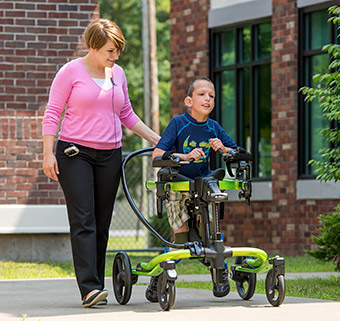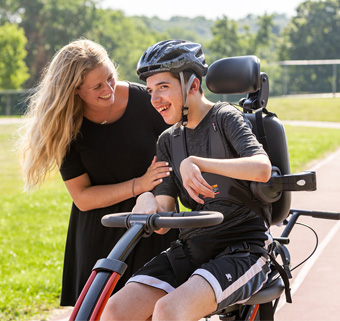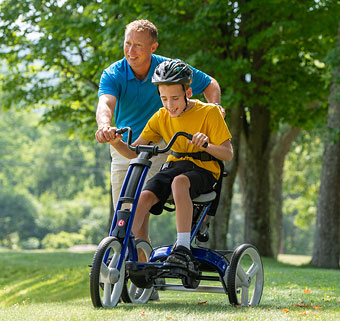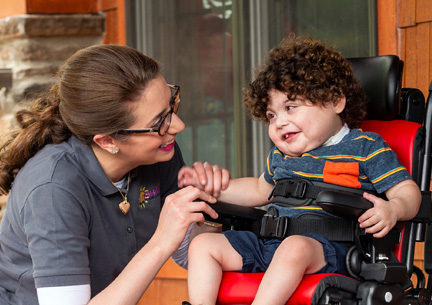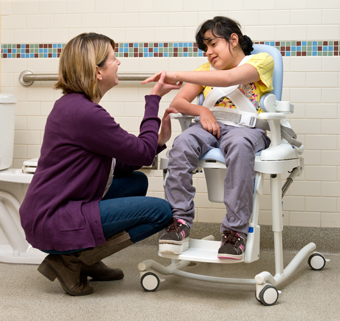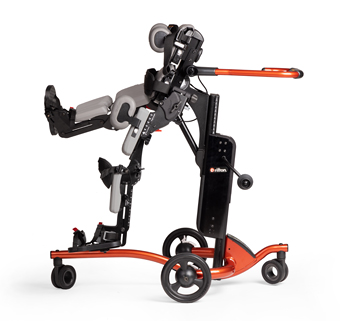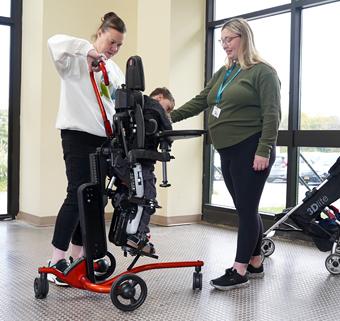It Started with a Bike: How Adaptive Cycling Builds Confidence and Connection
| February 2025 As pediatric therapists involved in the school special interest group of the APTA Pediatrics, our goal is to improve the success and quality of life of children with medical complexity in the classroom and beyond. Children with medical complexity are defined as having high health care needs, one or more chronic conditions, and often requiring medical technology and significant environmental modifications (Cohen et al, 2011). The school is a natural setting for improving participation for children of all abilities, and as physical therapists we play an important role in supporting movement and learning in this environment.
As pediatric therapists involved in the school special interest group of the APTA Pediatrics, our goal is to improve the success and quality of life of children with medical complexity in the classroom and beyond. Children with medical complexity are defined as having high health care needs, one or more chronic conditions, and often requiring medical technology and significant environmental modifications (Cohen et al, 2011). The school is a natural setting for improving participation for children of all abilities, and as physical therapists we play an important role in supporting movement and learning in this environment.
Decision-making and determining appropriate interventions is often a challenge for this population, especially as there are few studies that provide strong evidence and guidelines.
Evidence and Interventions for Children with Medical Complexity
Information from available studies, however, highlights activities and interventions that help build independent movement, mobility, and functional skills including leisure skills and socialization. Self-determination is another important component of education and can improve quality of life (Mumbardó-Adam et al, 2018). Self-determination includes the ability to choose one’s path, initiate, and carry out actions. Autonomy, a component of self-determination, is encouraged through self-initiated movement and often leads to the acquisition of other motor skills (Elad et al, 2018).
In addition, exercise is an important part of maintaining a healthy life and helps prevent secondary impairments and diseases. The World Health Organization (WHO) defines exercise as “bodily movement produced by skeletal muscles and which requires energy expenditure.” This includes all movements including leisure activities and transport (WHO 2024). It is difficult for our students to move and many of them do not have easy access to outlets for exercise, especially those with medical complexity and those who function at Gross Motor Function Classification System (GMFCS) Levels III, IV and V. Improving access to movement improves health related quality of life even for individuals who require assistance to move (Dodds et al, 2014). For example, a systematic review and meta-analysis by Armstrong et al (2019) found that children with cerebral palsy (CP) across all abilities and GMFCS levels who participated in cycling interventions demonstrated improvement in hamstring muscle strength and cardio-respiratory fitness as well as other benefits.
So how do we promote both a healthy lifestyle and also build self-determination in this population? How do we work on functional skills and make it meaningful and fun? Many of our students require frequent and repeated practice to improve learning and engagement, and many activities require a team approach. All therapists, teachers, and support staff will need to provide assistance and recommendations. A school-based biking program is an excellent way to apply these concepts.
School-Based Cycling Program
Listed below are ideas from several teachers and therapists on how to collaborate and create an effective school-based biking program. These ideas can be put into practice to allow children of many abilities to participate. The goals of the cycling programs initially included improving alertness and exercise capacity, but grew into so much more.
Because many of our students have limited active movement, having an adapted bike such as a Rifton Tricycle has many benefits: It is easy to fit, provides multiple seating options, allows for easy transfers, and has a steering bar option. When a student is first learning to ride, using an adapted bike or tricycle that has a direct drive with a 1:1 gear ratio is important. This means that when the bike is moved or pushed forwards, the pedals will rotate as well, guiding the legs in the motion. This fosters the idea that movement of the student’s legs creates movement of the bike.
To begin with, the bike route should be simple and short, such as cycling indoors, to avoid any changes in surface. Tactile cues at the legs or pedals to guide movement and verbal cues, along with incentives such as a favorite toy or song are important in the initial phases of teaching. It would be ideal for several students to bike together to foster socialization. Providing well-timed breaks and short, successful rides will be important at the beginning. As students learn the basics of riding, the time can be extended. Determining a consistent time of day for this activity can also be beneficial.
Once your program is up and running there are additional challenges that can be added to the program to improve mobility, endurance, functional tasks and promote self-determination.
- Wearing a helmet is required in our program, even when riding inside. However, most students will require help to put it on and off initially. Although we do not like to add too many demands at the beginning, as the students get into the routine, hand-over-hand assistance for donning and doffing or giving a gesture or using a device to identify the need for help will start to foster communication and independence.
- Adding a team shirt which is put on before and taken off after riding can also help with dressing goals.
- For students that require more assistance, a switch or gesture may be used to signal the need for assistance. Mounts can be put on the adapted tricycles/bikes to mount communication devices or switches.
- Include turns during the route to foster autonomy and self-determination (i.e. helping to choose the path of travel), language skills, and to help work on body awareness including right/left identification.
- Riding over small obstacles or biking outside will add extra challenges.
- Walking to the bike instead of bringing the bike to the classroom improves transfer skills, the ability to transition, and mobility.
- Adding signs to work on simple concepts such as Stop, Go, Walk, etc. can be beneficial.
- Making a delivery route where the student can use switches or communication devices to interact can make the session fun.
 Additional Tips
Additional Tips
Once your program is established remember to start to use the bikes in other environments. Biking is not only a form of exercise. It helps to foster independence and choice making. It can also become a social event, so remember to include other students (clubs, Adapted or Unified PE, etc). Additionally, when a child can’t walk for an activity, a bike can often be used. While students with significant mobility impairments may have difficulty biking long distances, the act of being with the group and experiencing movement can be very beneficial. If these students need a break and the rest of the group is still riding, they can use the wheelchair and a communication device to signal stop/go directions to the attendant to continue to engage in the activity.
Sample Goals for Adaptive Cycling Programs
Our cycling program uses goals aligned with the “Smart Goals” format: Specific, Measurable, Achievable, Relevant, Time-bound.
Sample goal 1: Given minimal assistance, the student will transfer to an adapted Rifton bike with a large seat on 75% of attempts, within four weeks, in order to participate in activities in the school setting.
Sample goal 2: In order to improve participation in PE with his peers, the student will be able to ride an adapted Rifton bike with supportive seating (laterals, chest harness, and pelvic belt), for at least five minutes with no more than occasional minimal assistance on 75% of attempts, within two weeks.
Sample goal 3: In order to improve participation in PE with peers, given verbal cues and practice, the student will navigate the Rifton Tricycle for four out of four turns or obstacles within six months.
Sample goal 4: In order to participate in a delivery task to build vocational skills, the student will be able to ride an adapted bike with moderate assistance, using a switch to communicate stop and go on at least three out of four attempts within four months.
Sample goal 5: In preparation for riding an adapted bike, the student will be able to don a helmet with no more than verbal cues on at least three out of four attempts within six months.
Goal Attainment Scaling (GAS) Goal Example
|
Attainment Level |
Score |
Description |
|
Baseline |
-2 |
Given assistance as needed on an adapted bike, the student will bike inside for 6 minutes in adapted PE with peers without stopping. |
|
Less than expected outcome |
-1 |
9 minutes |
|
Expected outcome |
0 |
12 minutes |
|
Greater than expected outcome |
1 |
15 minutes |
|
Much greater than expected outcome |
2 |
18 minutes |
References
- Armstrong EL, Spencer S, Kentish MJ, Horan SA, Carty CP, Boyd RN. Efficacy of cycling interventions to improve function in children and adolescents with cerebral palsy: a systematic review and meta-analysis. Clin Rehabil. 2019 Jul;33(7):1113-1129.
- Cohen E, Kuo DZ, Agrawal R, et al. Children with medical complexity: an emerging population for clinical and research initiatives. Pediatrics. 2011;127(3):529-538.
- Dodds CB, Bjornson KF, Sweeney JK, Narayanan UG. The effect of supported physical activity on parental-reported health-related quality of life in children with medical complexity. J Pediatr Rehabil Med. 2015;8(2):83-95.
- Elad D, Barak S, Silberg T, Brezner A. Sense of autonomy and daily and scholastic functioning among children with cerebral palsy. Res Dev Disabil. 2018 Sep;80:161-169.
- Mumbardó-Adam C, Guàrdia-Olmos J, Giné Giné C. An integrative model of self-determination and related contextual variables in adolescents with and without disabilities. J Appl Res Intellect Disabil. 2020 Sep;33(5):856-864.
- Physical Activity. World Health Organization. Updated June 26, 2024. https://www.who.int/news-room/fact-sheets/detail/physical-activity
